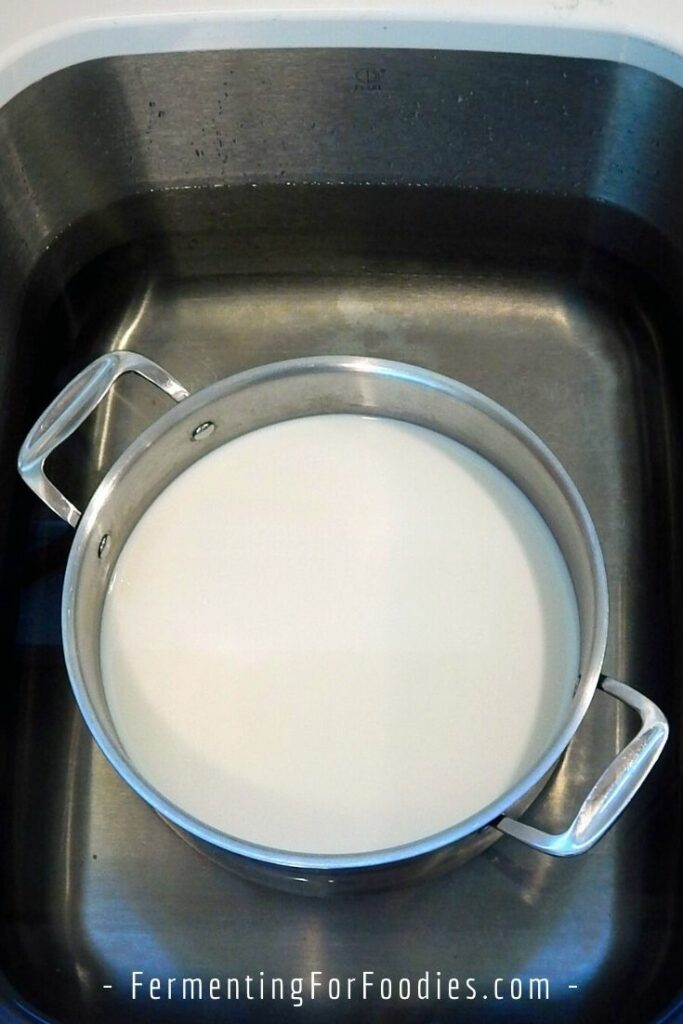The first step to making cheese is inoculating milk with culture, then setting the curd with rennet. Here’s a step-by-step breakdown of this process.

This post on inoculating milk for cheesemaking is part of a series of posts on cheesemaking. Check out How to make cheese for a complete list of topics.
1. Heat the milk
Milk needs to be warmed up to the right temperature to culture the bacteria.
The milk can be heated on the stove, stirring frequently to make sure the milk heats evenly (my usual method). The milk can also be heated in a microwave or over a double boiler.
Whatever you do, don’t overheat the milk. If the milk gets too hot it will cause the protein to denature and you won’t be able to make cheese.
Here’s a general temperature guide for heating milk. Regardless, it is always best to follow your recipe.
- Goat milk is heated to 88F (31 C) or less, regardless of culture.
- Mesophilic cultures usually culture at 90 F (32 C)
- Thermophilic cultures usually culture 91.5F (33C).
2. Add bacterial culture
Once the milk is at the right temperature, stir in the bacterial culture and maintain the temperature. As long as the milk is at the right temperature, the lactic bacteria will break down the lactose and acidify the milk. This is important because each type of cheese has its own level of acidification.
Cheese producers test the acidity levels, however, that sort of precision isn’t necessary for homemade cheese. To achieve the right level of acidification:
- Start with a reliable recipe
- Use the right type of culture
- Maintain the correct temperature for the right amount of time
I maintain the temperature of my milk using my Brød & Taylor Bread Proofer & Yogurt Maker. Milk can also be kept warm by nesting the pot in a basin of warm water and maintaining the temperature by adding boiling water to the basin. See cheesemaking equipment for more information.

3. Set the curd and condition the milk
Calcium Chloride
If you are using goat milk, sheep milk, or pasteurized cow milk, then you need to condition the milk with calcium chloride.
- For each gallon of milk, mix 1/4 tsp of food-grade liquid calcium chloride into 1/4 cup of chlorine-free water.
- Thoroughly stir the calcium chloride into the milk for about 5 minutes before adding the rennet.
Rennet
Here’s how to add rennet to set the curd:
- Mix the rennet (either liquid rennet or a rennet tablet) in a 1/4 cup of chlorine-free water (or as directed on the package).
- When the rennet is fully mixed into the water, stir the rennet water into the milk. Stir thoroughly for about 5 minutes, mixing the milk up from the bottom of the pot so that the rennet is well-distributed.
- Continue to maintain the temperature of the milk, without stirring, so the rennet can set the curd. This usually takes about 30 minutes.
For more information on testing the curd and turning it into cheese see preparing cheese curd.
Hi Emillie,
Is there a typo? Is there really only one and half degrees in temperature between meso and thermophilic? Am I misunderstanding something?
cheers,
Ruben.
I know… it is weird, but not a typo. The difference is in the temperature needed to make the culture in the first place. The curds usually get cooked at a hotter temperature (next step) which is more akin to the yogurt culturing temperature anyways.
Thanks for reading! Emillie
Interesting. So maybe it is the curd cooking temp that gives the name of meso or thermo…?
if I do not have the rennet, may I use the lemon juice for curling?
There are many different types of cheese. Lemon juice or vinegar can be used to make a cheese like pannier or acid ricotta. If you want to make a cultured cheese (without investing in cheese culture) you could use milk kefir, buttermilk or yogurt. Each of these makes their own type of cheese (in this case, kefir cheese, cottage cheese, lebeneh). Check out my cheese recipes for some of these recipes: https://www.fermentingforfoodies.com/cheese
Why is my Gouda cheese rubbery. It is 3 weeks old. If it meature longer will it become creamy?
It could be due to a few different reasons: too much rennet or overheating during the culturing. Unfortunately, there’s nothing you can do about your current batch of cheese. But it will still be good as a melting cheese. You might just need to adjust your recipe slightly for the next time. Good luck!